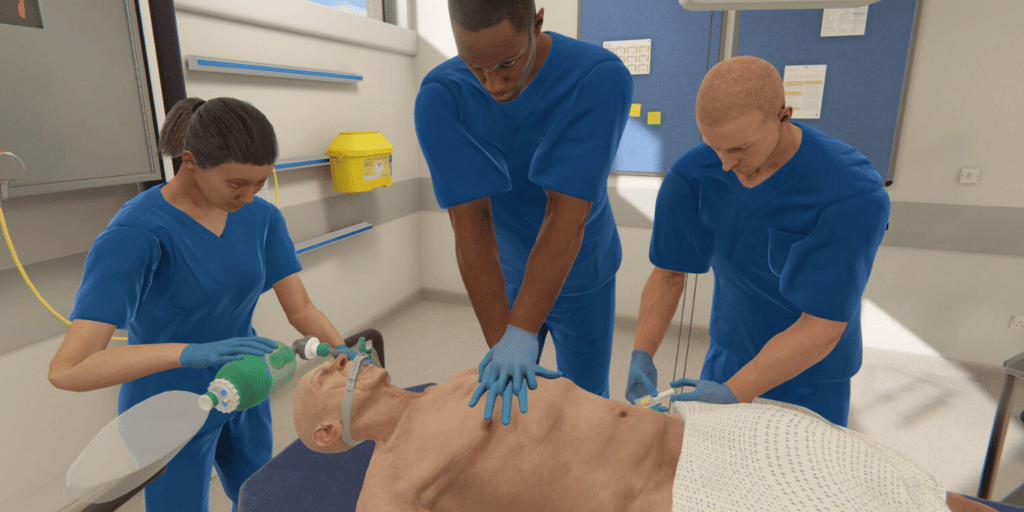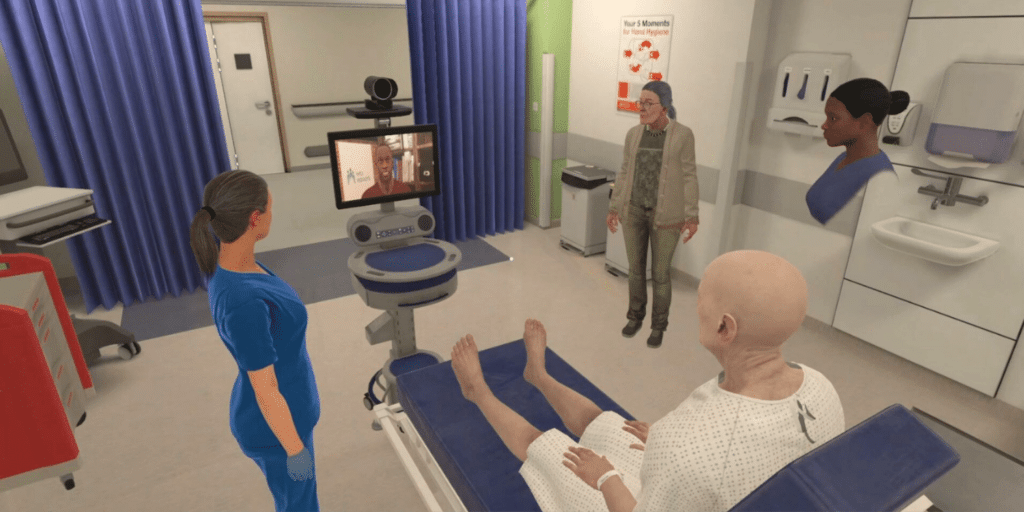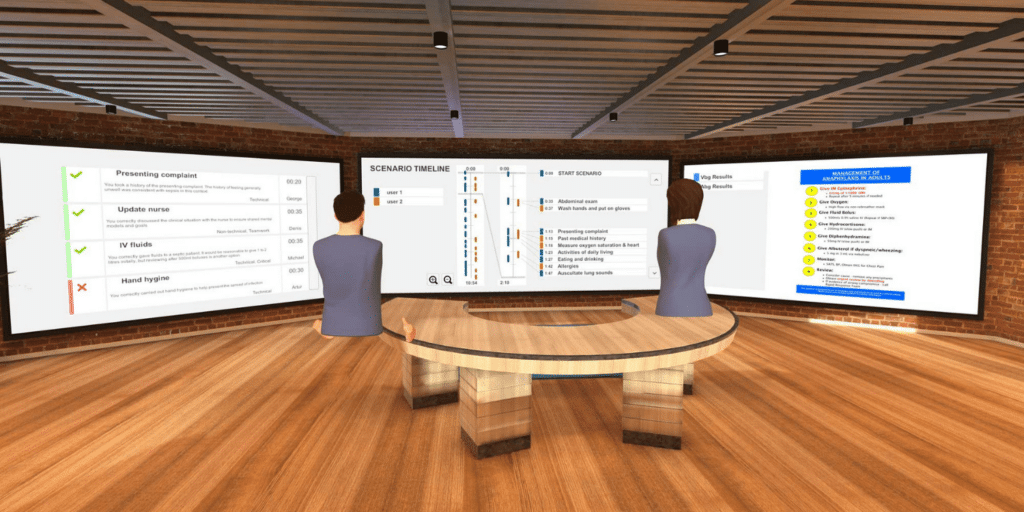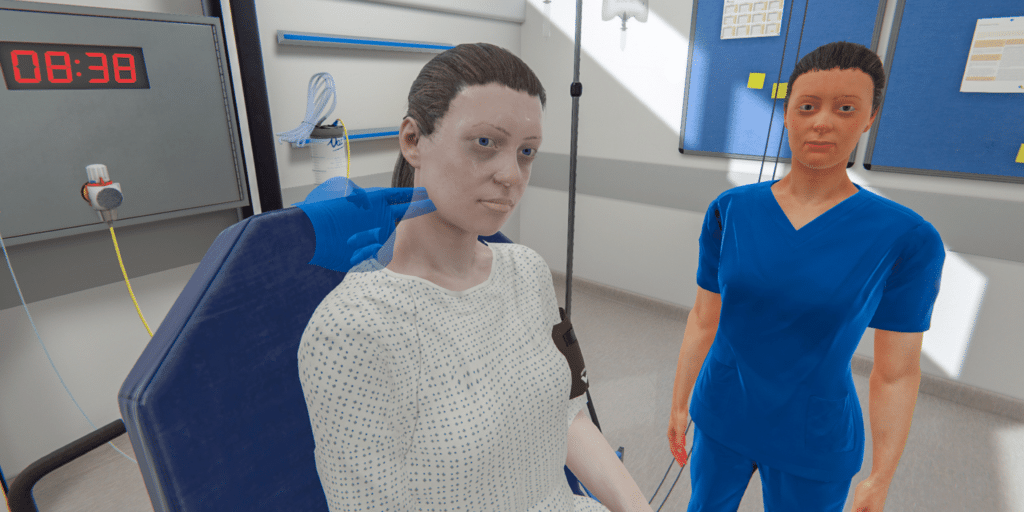Building a safe space for a working environment is imperative to interdisciplinary team success in healthcare settings.
Team building exercises are often done in person, and as scheduling across multiple disciplines is difficult, it can be few and far between for everyone on the team to come together at the same time for team-focused activities.
VR can be used as a way to connect the interprofessional team from any space, providing similar benefits to that of in-person team building simulations.
OMS Interprofessional Scenarios
OMS offers a suite of multidisciplinary scenarios that encourage teamwork, communication, and collaboration for safe and effective patient care.
No matter where your learners are, they can enter the same simulation with their colleagues to exchange ideas, learn about other roles, and gain a deeper understanding of the intricacies of interprofessional teamwork.
Together, learners examine, diagnose, and come to decisions on how best to treat patients who are acutely unwell.
These scenarios have a direct focus on team-oriented decision-making, critical thinking, communication, and clinical reasoning through acute situations including (but not limited to):
- Advanced cardiovascular life support (ACLS)
- Diabetic ketoacidosis
- Pulmonary edema
- Anaphylaxis

Beyond what is completed in the scenario itself, learners also get the opportunity to debrief as a group, opening up a dialogue on where the team performed well and which areas have room for improvement.
Interprofessional Roles in Scenarios
There are two main types of roles that both learners and trainers or faculty can take on in the simulation – active and observer.
Active roles include the lead role and the assisting role, who both play active parts in the progression of the scenario. These learners directly communicate with one another to gather relevant information, perform tests and measures, interpret results, and conduct interventions.
In order to complete the scenario and effectively manage the care of the patient, learners must collaborate to distribute tasks and maintain open communication throughout the simulation.
This delineation of roles allows for one learner to take on a leadership role within their team, practicing delegation, just as interprofessional teams work together in clinical settings. Denoting roles can also be beneficial in the understanding of the roles and responsibilities of healthcare professionals from other disciplines.

Observers, on the other hand, have the opportunity to get a view, from any angle, of how the scenario is unfolding and how the team is working together. This can inform and provide greater context for debriefing discussions amongst the team following the simulation.
Learners or faculty can take on any role, depending on the goal of the scenario and learning objectives, and with OMS Create, faculty can control the patient’s actions, speech, or vitals just as they can in physical simulation.
If for any reason, planned or unplanned, one participant exits the scenario, roles can be changed mid-simulation. For example, if you’d like to have one learner begin in the assist role and later take on the lead role, that can be planned for prior to entering the simulation.
In OMS Interprofessional scenarios, learners have the opportunity to come together from across a wide range of disciplines to work as a team with a focus on crisis resource management, teamwork, and communication skills with their colleagues, reflecting the everyday work done by interprofessional teams across healthcare systems.
Team-Based Feedback
Similarly to single player scenarios, OMS Interprofessional simulations automatically populate with feedback upon completion of the scenario and self-guided reflective questions.
However, the feedback provided for multiple participants is team-based, so learners can continue working as a group as they debrief.

As expected, feedback details areas that went well during the scenario and where there is room for improvement of future performance. This evidence-based feedback also provides learners with rationale, giving a more robust explanation of why certain actions are important and how those concepts relate to practice.
Additionally, a scenario timeline is constructed and shown to the learners. This timeline contains timestamps for actions taken during the simulation, as well as identifiers for who took which action, providing a visual representation of how the scenario unfolded.
Finally, learners can go back to review reports that were conducted during the simulation. This may include any imaging, lab results, or guidelines that were relevant to the context of the scenario.
How one university encouraged interprofessional collaboration with OMS
NOVA Southeastern University Health Professions Division created an Interprofessional Education Day utilizing OMS Interprofessional scenarios.
They brought together over 2,000 students, faculty, and staff from over 16 disciplines as a part of this day to encourage collaboration and deeper understanding of the interdisciplinary team.
Prior to the IPE day, faculty recorded a scenario that brought together one student each from pharmacy, medicine, and physician assistant programs. Together, they entered an OMS Interprofessional scenario and collaborated on the treatment of an acutely unwell patient.
Their entire experience was recorded, and on the IPE day, groups of learners were able to view the recorded simulation and debrief on what they observed.
This particular experience made for rich debriefing discussions, as an incorrect medication was administered during the scenario. This not only brought about discussions on checks and balances for medication administration, but it also encouraged a meaningful discussion on psychological safety at work and speaking up within a cross-functional team to ensure patient safety at every stop.
Interprofessional scenarios can accommodate multiple learners in each scenario, and for some, that can mean having a classroom of learners participate in the same simulation, at the same time. From three to 300 to 2000 – there’s a way for everyone to get involved and benefit from interdisciplinary team-building simulations.
With OMS Interprofessional scenarios, learners enter the scenario together, and they exit the scenario together. As a group, they are responsible for the outcome of the simulation, and they are able to take time following the scenario to engage and discuss with one another about how they performed as a unit to positively impact the patient.
These scenarios foster interprofessional communication and collaboration in a psychologically safe environment, encouraging learners from all healthcare disciplines to come together and build the foundation for interprofessional care.
To learn more about the ways in which you can use interprofessional scenarios to foster collaborative interdisciplinary teams, set up a time for a demo here.
